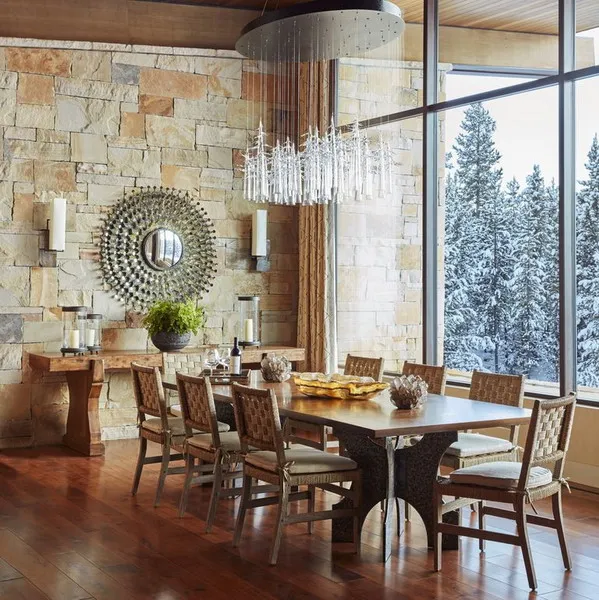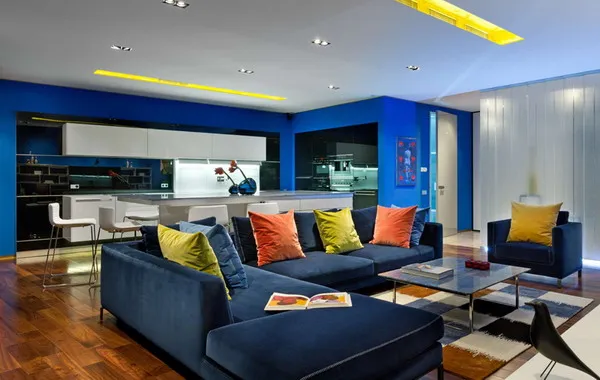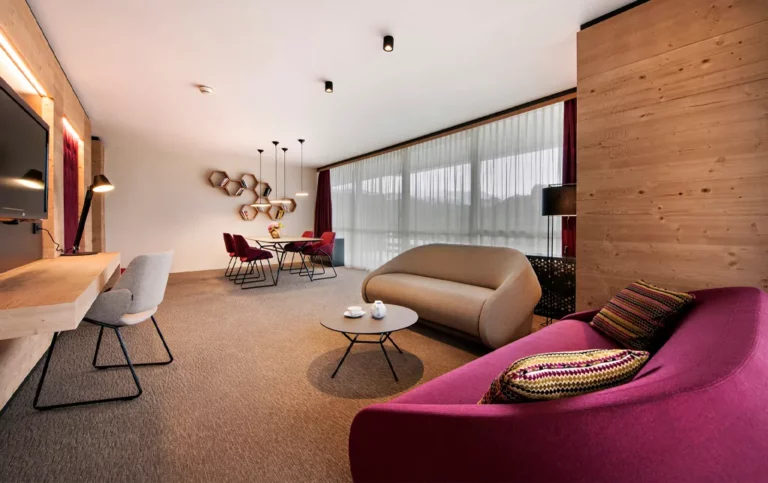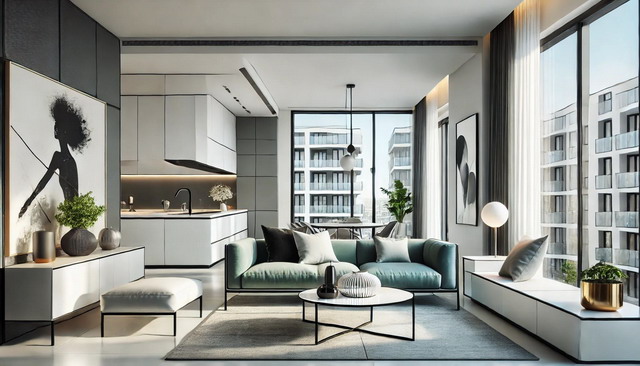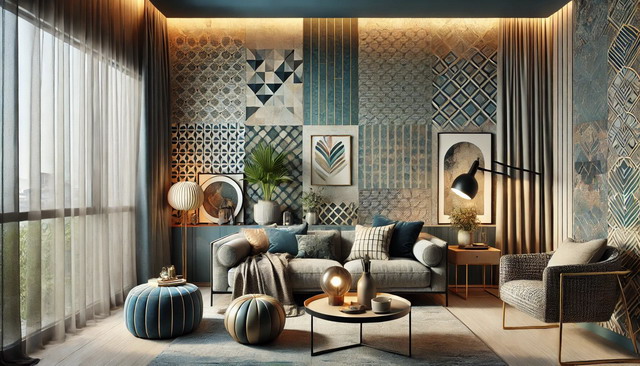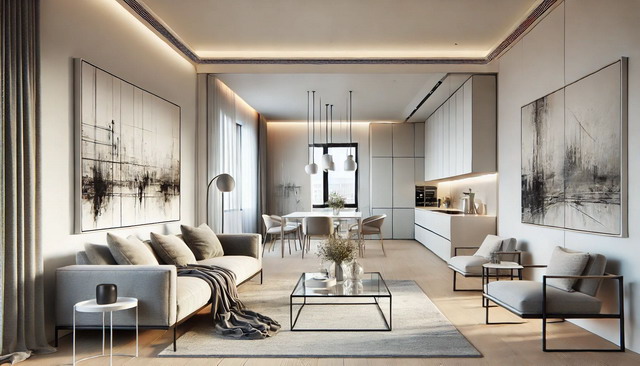Flooring Trends 2025: Innovative Designs & Materials for Modern Ho
Last Updated on September 14, 2024 by Mutiara
As we move into 2025, the world of interior design continues to evolve, with flooring trends leading the charge in creating both functional and beautiful spaces. Homeowners and designers alike are embracing a range of innovative materials, textures, and technologies that not only enhance the aesthetics of a home but also align with environmental sustainability and modern living needs.
The flooring choices you make in 2025 will be about more than just walking surfaces—they’ll play a crucial role in creating energy-efficient, eco-conscious, and tech-savvy living spaces. This year is all about pushing boundaries with smart flooring technologies, environmentally friendly materials, and fresh design perspectives that meet the changing demands of both homeowners and the planet.
In this post, we’ll delve into two key flooring trends for 2025: eco-friendly flooring materials and the latest innovations in luxury vinyl flooring. These trends are shaping the way we think about flooring, focusing on durability, sustainability, and the overall experience of living in modern homes.
Eco-Friendly Flooring Materials 2025: Sustainability Meets Style
One of the most significant flooring trends for 2025 is the shift toward eco-friendly materials. As environmental concerns continue to influence consumer choices, the demand for sustainable flooring options is growing at an unprecedented rate. In 2025, homeowners are more conscious of their environmental impact and are seeking ways to reduce their carbon footprint, starting with the materials used in their homes.
Why Eco-Friendly Flooring is Taking Over
Sustainability is no longer just a buzzword; it’s a lifestyle choice that consumers are integrating into every aspect of their lives, from the food they eat to the products they use—and now, to the floors they walk on. Eco-friendly flooring materials are gaining popularity because they are not only better for the environment but also healthier for our homes. Many traditional flooring materials release volatile organic compounds (VOCs) that can negatively affect indoor air quality. Sustainable alternatives, however, often come with lower emissions, making homes safer and more comfortable.
Moreover, sustainable flooring materials are now designed to be just as durable and aesthetically pleasing as their non-eco counterparts. With a variety of textures, colors, and finishes available, homeowners no longer have to sacrifice style for sustainability.
Top Eco-Friendly Flooring Materials in 2025
- Bamboo Flooring:
Bamboo has been a favorite among eco-conscious homeowners for years, and it remains at the top of the list in 2025. What sets bamboo apart is its fast growth rate—bamboo can be harvested in as little as three to five years, compared to hardwood trees, which can take up to 50 years to mature. Bamboo is highly durable and offers a sleek, modern look, making it a popular choice for contemporary homes. - Cork Flooring:
Another eco-friendly option gaining momentum in 2025 is cork flooring. Cork is harvested from the bark of cork oak trees, a process that doesn’t harm the trees themselves. This renewable material is naturally hypoallergenic, resistant to mold and mildew, and offers excellent insulation properties. With a soft and cushioned feel underfoot, cork is perfect for areas where comfort is a priority, such as living rooms or bedrooms. - Recycled Wood Flooring:
For homeowners who prefer a more classic look, recycled or reclaimed wood flooring is a sustainable option. Reclaimed wood is sourced from old buildings, barns, and factories, giving it a unique character and history. Using recycled wood not only reduces the demand for newly harvested timber but also preserves the authenticity and beauty of natural wood. - Linoleum Flooring:
Often confused with vinyl, linoleum is a natural flooring material made from linseed oil, cork dust, and wood flour. In 2025, linoleum is making a comeback as an eco-friendly option, known for its durability, affordability, and resistance to wear and tear. It’s a great choice for homeowners looking for a versatile, easy-to-maintain floor that comes in a variety of colors and patterns.
The Benefits of Choosing Sustainable Flooring
Choosing eco-friendly flooring offers numerous benefits beyond environmental sustainability. First, many of these materials are incredibly durable and long-lasting, meaning they won’t need to be replaced as often as traditional flooring options. This reduces waste and saves money in the long run. Additionally, sustainable flooring materials can contribute to healthier indoor air quality, making homes more comfortable and safe, especially for those with allergies or respiratory issues.
Furthermore, eco-conscious flooring can boost a home’s resale value. As sustainability becomes an increasingly important factor for homebuyers, having eco-friendly features like sustainable flooring can make a property more attractive on the market.
Luxury Vinyl Flooring Innovations: High-Tech Meets High Style
While eco-friendly materials are taking the lead in 2025, the rise of luxury vinyl flooring (LVF) is a trend that cannot be overlooked. Vinyl flooring has come a long way from its origins as a budget-friendly, less-than-stylish option. In 2025, luxury vinyl flooring is at the forefront of innovation, combining advanced technology with exceptional style.
Why Luxury Vinyl Flooring is Trending in 2025
Luxury vinyl flooring has become a favorite among homeowners because of its ability to mimic the look and feel of more expensive materials like hardwood, stone, and tile—at a fraction of the cost. This affordability, paired with its durability and low maintenance, makes luxury vinyl flooring an attractive option for busy households.
Another reason LVF is trending in 2025 is its versatility. It can be installed in any room of the house, including high-moisture areas like bathrooms and kitchens, thanks to its waterproof properties. Additionally, LVF is available in a wide range of styles, colors, and textures, allowing homeowners to achieve virtually any design aesthetic they desire.
Technological Advancements in Luxury Vinyl Flooring
In 2025, luxury vinyl flooring is benefiting from cutting-edge technological advancements. One of the most significant innovations is the development of rigid core technology, which makes LVF even more durable and stable. Rigid core LVF is resistant to dents, scratches, and water damage, making it ideal for high-traffic areas or homes with pets and children.
Another innovation is the use of 3D printing technology to create incredibly realistic textures and patterns on vinyl flooring. This allows LVF to replicate the look of natural materials like wood or stone with an unprecedented level of detail and authenticity.
Additionally, smart flooring technology is being integrated into LVF, allowing homeowners to monitor temperature, detect water leaks, and even integrate their flooring with smart home systems. This technological leap is making luxury vinyl flooring more than just a surface to walk on—it’s becoming an integral part of the home’s functionality.
In 2025, flooring is no longer just a practical necessity; it’s an opportunity to make a statement, embrace sustainability, and incorporate cutting-edge technology into your home. Whether you’re drawn to the eco-friendly appeal of bamboo and cork or the high-tech innovation of luxury vinyl, the flooring trends for 2025 offer something for every style, budget, and lifestyle.
Smart Flooring Technology for Homes in 2025: Where Innovation Meets Functionality
The future of flooring in 2025 is not just about materials and aesthetics—it’s also about integrating technology into our living spaces. Smart homes are becoming the norm, and flooring is catching up with this trend. In 2025, smart flooring technology is gaining traction as homeowners look for ways to make their homes more efficient, safe, and connected.
What is Smart Flooring Technology?
Smart flooring technology refers to advanced flooring systems equipped with sensors, automation features, and connectivity to other smart home devices. These floors can detect motion, monitor room temperature, and even track activity levels. They can be integrated into your home’s ecosystem, syncing with lighting, heating, security systems, and more. Smart floors add a layer of functionality to homes that goes beyond aesthetics, making them a crucial part of the smart home experience.
How Smart Floors Are Enhancing Modern Homes
- Motion and Occupancy Sensors:
Smart floors with built-in motion sensors can detect when someone enters or leaves a room. This feature can trigger other smart devices like lights or heating systems, improving energy efficiency. For example, the lights could automatically turn on when someone walks into a room and turn off when the room is unoccupied. These sensors can also help with security, alerting homeowners to unusual activity when no one is supposed to be home. - Health and Wellness Monitoring:
Some smart flooring systems are designed to monitor activity levels and detect falls, which can be especially useful for elderly or disabled residents. In the event of a fall, the flooring system can send an alert to family members or emergency services, offering a higher level of safety. Smart flooring can also track steps and monitor weight distribution, providing valuable health insights for fitness enthusiasts. - Temperature and Climate Control:
In 2025, some smart flooring systems are integrated with radiant heating technology, allowing homeowners to control the temperature of individual rooms. This not only enhances comfort but also improves energy efficiency by heating only the rooms that are in use. Some systems even sync with smart thermostats to create an optimal indoor climate, ensuring that every corner of your home is cozy and energy-efficient.
The Future of Flooring Integration with Smart Homes
Smart floors are part of a broader movement towards home automation, where every element of the house is interconnected. Imagine floors that communicate with your security system, lighting, and heating to create a seamless living experience. The future of flooring is about more than just functionality; it’s about making homes more intuitive and responsive to the needs of their inhabitants.
As this technology continues to develop, we can expect even more innovative uses for smart floors, such as integrated charging for electric devices or floors that help manage indoor air quality. The possibilities are endless, making smart flooring one of the most exciting trends to watch in 2025.
Waterproof and Pet-Friendly Flooring Options: Durability Meets Practicality
For homeowners in 2025, practical concerns like water resistance and pet-friendliness are becoming increasingly important when choosing flooring. With the rise of open-concept living spaces and an increase in pet ownership, floors need to withstand more wear and tear than ever before. Waterproof and pet-friendly flooring options are leading the charge in providing durable, functional, and stylish solutions for modern homes.
Why Waterproof Flooring is a Must in 2025
Waterproof flooring has become a necessity for many homeowners, particularly in areas like kitchens, bathrooms, basements, and laundry rooms where moisture is a concern. However, in 2025, waterproof flooring is being used throughout the home, thanks to its durability and low maintenance.
- Luxury Vinyl Planks (LVP):
Luxury vinyl planks are at the forefront of waterproof flooring options. LVP is designed to mimic the appearance of natural wood, stone, or tile, but with the added benefit of being completely waterproof. This makes it ideal for households with pets, children, or high foot traffic. LVP is also highly scratch-resistant, making it perfect for homes where durability is a priority. - Waterproof Laminate Flooring:
Laminate flooring has long been a popular choice for homeowners due to its affordability and ease of installation. In 2025, waterproof laminate has emerged as an even more practical option. With advancements in sealing technology, waterproof laminate can now handle spills and moisture without warping or buckling, making it an excellent choice for kitchens and bathrooms. - Porcelain and Ceramic Tiles:
For those seeking a more traditional look, porcelain and ceramic tiles remain the go-to option for waterproof flooring. These materials are impervious to water and are available in a wide range of styles, from classic to contemporary. Tiles are also easy to clean and maintain, making them a practical choice for busy households.
The Rise of Pet-Friendly Flooring in 2025
With more homeowners opting for pet-friendly environments, flooring that can withstand the demands of pets is more important than ever. In 2025, pet-friendly flooring focuses on durability, scratch resistance, and ease of cleaning.
- Vinyl Flooring for Pets:
Vinyl flooring is one of the best options for pet owners in 2025. It’s waterproof, scratch-resistant, and provides a soft underfoot feel, which is easier on pets’ joints compared to harder surfaces. Additionally, vinyl floors are easy to clean, making it simple to deal with any accidents or spills. - Engineered Hardwood:
For those who love the look of hardwood but need something more durable for pets, engineered hardwood is an excellent alternative. This flooring type has a solid wood veneer on top of a sturdy, multi-layer core, making it more resistant to scratches and dents. While it’s not entirely waterproof, engineered hardwood can withstand more wear and tear than traditional hardwood, making it a pet-friendly option. - Cork Flooring:
Cork is a natural, eco-friendly option that is also great for pets. It’s soft underfoot, providing comfort for both humans and animals, and it has natural antimicrobial properties, which help reduce odors from pet accidents. Cork is also highly scratch-resistant and can absorb sound, making it ideal for homes with pets that tend to make a lot of noise.
The Benefits of Waterproof and Pet-Friendly Flooring
Waterproof and pet-friendly flooring options provide a range of benefits, particularly for busy households. First and foremost, these materials are designed to withstand moisture, spills, and high traffic, making them ideal for active families and pet owners. They are also low-maintenance, easy to clean, and often more durable than traditional flooring options.
Additionally, pet-friendly flooring materials are designed with comfort in mind. Many of these floors are softer and warmer underfoot than tile or hardwood, making them more comfortable for pets (and humans) to walk and lie on.
Sustainable Hardwood Flooring Choices: Going Green with Timeless Elegance
Hardwood flooring has long been a staple in home design, known for its timeless beauty and durability. In 2025, the focus is on sustainable hardwood options, as more homeowners look for ways to combine elegance with eco-conscious living. Sustainable hardwood flooring is sourced from responsibly managed forests, ensuring that these natural resources are preserved for future generations.
The Importance of Sustainable Hardwood Flooring in 2025
Sustainability is a key consideration for many homeowners in 2025, and hardwood flooring is no exception. Traditional hardwood can contribute to deforestation, so choosing sustainable options is a way to enjoy the beauty of wood while minimizing environmental impact.
- FSC-Certified Wood:
One of the best ways to ensure that your hardwood flooring is sustainable is to look for products that are certified by the Forest Stewardship Council (FSC). FSC certification guarantees that the wood has been harvested responsibly and that the forest’s biodiversity is preserved. In 2025, FSC-certified wood is widely available and comes in a variety of species, from oak to walnut. - Reclaimed Wood Flooring:
Reclaimed wood is an eco-friendly option that repurposes wood from old buildings, barns, or factories. Each plank of reclaimed wood has its own unique character, offering a rustic, authentic look that new wood simply can’t replicate. By using reclaimed wood, homeowners are reducing the demand for new timber and giving old materials a new lease on life. - Engineered Hardwood:
Engineered hardwood is another sustainable option for 2025. Unlike solid hardwood, which is made from a single piece of wood, engineered hardwood consists of a thin layer of hardwood on top of a core made from recycled wood or plywood. This construction method uses less solid wood, making it a more environmentally friendly choice.
The Future of Sustainable Hardwood Flooring
In 2025, sustainable hardwood flooring is not just about the wood itself—it’s also about the finishes and treatments used. Water-based finishes are becoming more popular, as they are less toxic and produce fewer VOCs compared to traditional oil-based finishes. Additionally, some manufacturers are using non-toxic adhesives and sealants, further reducing the environmental impact of hardwood floors.
The shift towards sustainability in hardwood flooring reflects a broader trend in home design: the desire to create spaces that are not only beautiful but also responsible. Sustainable hardwood floors offer the perfect balance of elegance, durability, and environmental consciousness, making them a top choice for homeowners in 2025.
As we navigate the flooring trends for 2025, it’s clear that the future of flooring is about more than just looks. Homeowners are seeking solutions that offer sustainability, durability, and smart integration, all while creating stylish, functional spaces. Whether you’re interested in eco-friendly materials, smart flooring technology, or pet-friendly options, the trends for 2025 have something to offer every homeowner.
Customization and Personalization in Flooring Design: Unleashing Creativity in 2025
In 2025, one of the most exciting flooring trends is the rise of customization and personalization. Homeowners are no longer confined to choosing from pre-designed patterns and colors; instead, they are embracing the freedom to create bespoke floors that reflect their unique tastes and preferences. This movement towards personalized design allows individuals to make bold, creative choices that transform flooring into a distinctive feature of the home, rather than just a functional surface.
The Appeal of Customized Flooring in 2025
The demand for customization reflects a broader trend in interior design: people want their living spaces to be a true expression of their personalities. In flooring, this is achieved through a variety of methods, including custom patterns, printed designs, and tailored color schemes. Thanks to advancements in technology, it’s now easier than ever to create floors that are truly one-of-a-kind.
- Custom Printed Flooring:
In 2025, digital printing technology has opened up a world of possibilities for custom flooring. Homeowners can now design their own patterns, textures, and images, which are then printed onto materials like vinyl, laminate, or even tile. Whether you want a floor that mimics the look of a rare wood species, a bold geometric pattern, or even a photograph, custom-printed flooring can bring your vision to life. This trend allows for total freedom of expression, making each room in the house uniquely yours. - Personalized Patterns and Layouts:
Customization also extends to the way floors are laid out. Homeowners are experimenting with different layout patterns—like herringbone, chevron, or basket weave—that add a touch of sophistication and artistry to a room. Mixed materials are another popular option, where different types of flooring (such as wood and tile) are combined to create striking contrasts and seamless transitions between different areas of the home. - Tailored Color Palettes:
In 2025, neutral tones are giving way to more adventurous color choices. Personalized flooring allows homeowners to move beyond the standard browns and greys, choosing instead from a wide array of colors that complement the overall design of their home. Whether it’s deep, dramatic tones like navy and emerald or light, airy pastels, custom flooring gives you the power to choose a color palette that perfectly suits your style.
Why Personalized Flooring is Worth the Investment
While custom flooring may come with a higher price tag than mass-produced options, it offers immense value in terms of creativity, uniqueness, and the ability to elevate a home’s overall design. Custom floors serve as a conversation piece, adding character to a room and making a lasting impression. Moreover, they allow homeowners to break free from traditional design rules, offering the flexibility to experiment with bold styles and personal touches that make a home truly one-of-a-kind.
Multi-Purpose Flooring for Versatile Spaces: Adapting to Modern Living Needs
As homes evolve to accommodate modern lifestyles, multi-purpose flooring has emerged as a crucial trend for 2025. The concept of multi-purpose flooring revolves around creating surfaces that can seamlessly transition between different uses, whether that’s from home office to living space, or from gym to playroom. As our homes become more multifunctional, flooring must rise to the challenge of being durable, adaptable, and stylish—no matter how it’s used.
The Need for Versatile Flooring Solutions
In the post-pandemic era, many people continue to work, exercise, and entertain from home. This shift has led to the rise of flexible living spaces that can be adapted for various purposes throughout the day. Multi-purpose flooring is designed to meet these needs by offering durability, comfort, and aesthetic appeal, regardless of how the space is used.
- Hybrid Flooring for Flexible Spaces:
Hybrid flooring is a major innovation for 2025, blending the best qualities of different flooring materials to create a product that is both durable and versatile. For example, hybrid vinyl flooring combines the water resistance of vinyl with the durability of laminate, making it ideal for spaces that see a variety of activities, from working to working out. This type of flooring is particularly well-suited for home offices that double as fitness areas or children’s playrooms that need to withstand high foot traffic and occasional spills. - Area-Specific Flooring Solutions:
In 2025, homeowners are increasingly opting for different types of flooring in different areas of a multi-functional room to enhance both practicality and design. For example, in an open-plan living space, luxury vinyl or laminate might be used for the main living area, while carpet tiles are installed in a designated play zone for added comfort. By using a combination of flooring materials, homeowners can create zones within a room, each suited to its specific purpose. - Noise Reduction and Comfort:
For spaces that serve multiple functions, comfort and sound absorption are important considerations. Cork flooring is an excellent option for multi-purpose rooms, as it provides a soft, cushioned surface that is ideal for standing desks, yoga sessions, or kids’ play areas. Cork also has natural sound-dampening properties, making it a great choice for reducing noise in busy households where different activities are happening simultaneously.
How Multi-Purpose Flooring Adds Value
Multi-purpose flooring not only adds flexibility to a home but also increases its overall functionality and appeal. With more people spending extended time at home, flooring that can adapt to different activities is a practical investment. Whether it’s working from home, entertaining, or exercising, multi-purpose floors are designed to handle it all, offering a solution that is both stylish and durable.
Textured Flooring Trends: Matte, Distressed, and Beyond
Texture is taking center stage in 2025 flooring trends, with homeowners increasingly opting for surfaces that engage not just the eye, but also the sense of touch. From matte finishes to distressed looks, textured flooring adds depth and dimension to a room, creating an inviting atmosphere and a sense of warmth. This trend reflects a broader desire to create more tactile, cozy spaces that balance modern aesthetics with a lived-in, comfortable feel.
Why Texture is Trending in 2025
In recent years, interior design has shifted away from ultra-polished, glossy finishes in favor of more organic, natural looks. Textured flooring fits right into this movement by offering a range of finishes that provide visual interest and enhance the overall design of a space.
- Matte Finishes:
Matte flooring, characterized by its low-gloss, velvety appearance, is a major trend in 2025. It offers a subtle, understated look that complements a wide range of design styles, from minimalist to rustic. Matte floors also have the added benefit of being more forgiving when it comes to showing scratches, smudges, and dust—making them a practical option for busy households. - Distressed and Weathered Wood:
Distressed or weathered wood flooring is a top choice for homeowners who want to add character and charm to their spaces. This type of flooring mimics the look of reclaimed or aged wood, with intentional imperfections like knots, cracks, and color variations. In 2025, distressed wood is being used to create a lived-in, vintage feel that contrasts beautifully with more modern design elements. The beauty of this flooring lies in its imperfections, making it perfect for those who prefer a more relaxed, casual style. - Hand-Scraped and Wire-Brushed Floors:
Hand-scraped and wire-brushed wood floors are also gaining popularity in 2025, offering a rich, textured surface that adds dimension to any room. These types of finishes enhance the natural grain of the wood, giving it a unique, handcrafted look. Hand-scraped floors, in particular, evoke a rustic, artisanal feel that makes them a favorite for farmhouse or cottage-style homes. Wire-brushed floors, on the other hand, have a more refined texture, making them suitable for modern and contemporary spaces.
How to Incorporate Textured Flooring into Your Home
Textured flooring can be used in a variety of ways to elevate the design of your home. In living rooms or bedrooms, textured wood or laminate adds warmth and coziness, making the space feel more inviting. In more functional areas like kitchens or hallways, textured tile or vinyl provides slip resistance while still delivering an attractive, modern look.
For homeowners who are hesitant to fully commit to textured floors, a great compromise is to use textured area rugs or carpets in combination with smoother flooring materials. This approach allows for the best of both worlds—sleek, low-maintenance flooring in high-traffic areas, and soft, tactile surfaces in more relaxing spaces.
The Benefits of Choosing Textured Flooring
Textured flooring offers a unique blend of style and practicality. In addition to being visually interesting, it’s also more forgiving when it comes to wear and tear. Scratches, dents, and other imperfections tend to blend in with the texture, making these floors more durable over time. Textured floors are also less slippery than polished surfaces, making them a safer option for households with children or elderly residents.
As we look ahead to 2025, it’s clear that flooring is no longer just about function—it’s about creativity, adaptability, and engaging the senses. Whether you’re drawn to the endless possibilities of custom designs, the practicality of multi-purpose solutions, or the tactile appeal of textured finishes, the flooring trends of 2025 offer something for every style and need.
Bold Color and Pattern Choices: Making a Statement with Flooring in 2025
One of the most eye-catching trends for 2025 is the return of bold colors and patterns in flooring. While neutral tones like grey and beige have dominated for years, homeowners and designers are now embracing vibrant hues and striking patterns that make flooring the focal point of a room. Whether it’s through geometric designs, artistic motifs, or daring color schemes, 2025 is the year to make a statement with your floors.
Why Bold Flooring Choices Are Trending
In 2025, there’s a growing desire for individuality and self-expression in interior design. Homeowners are no longer content with playing it safe, opting instead for flooring that reflects their personality and sense of style. Bold colors and patterns offer a way to infuse energy and creativity into a space, transforming floors from a neutral background into a key design feature.
- Geometric Patterns and Shapes:
Geometric flooring patterns—such as hexagons, diamonds, or chevrons—are a huge trend in 2025. These designs add a sense of movement and rhythm to a room, creating dynamic visual interest. Geometric tiles in contrasting colors are especially popular in kitchens, bathrooms, and entryways, where the floors can serve as a design focal point. Homeowners are also experimenting with mixed shapes and sizes, creating custom layouts that feel both modern and artistic. - Vibrant Colors:
For those looking to break away from the typical neutral palette, 2025 brings a resurgence of bold color choices in flooring. Rich, saturated hues like deep blues, emerald greens, and even burnt oranges are becoming popular, especially in spaces where homeowners want to create a lively, welcoming atmosphere. Bold colors can be used across the entire floor for a dramatic effect, or they can be incorporated through patterned tiles and carpets that mix neutrals with pops of color. - Artistic Motifs and Custom Designs:
In 2025, flooring is taking inspiration from the world of art. Custom designs featuring floral patterns, abstract shapes, or cultural motifs are gaining popularity, allowing homeowners to create floors that feel more like a work of art than a traditional surface. Advances in tile and vinyl printing technology make it easier than ever to achieve these custom designs, whether you want to replicate a classic Mediterranean tile pattern or create something entirely unique.
How to Incorporate Bold Flooring into Your Home
While bold flooring can make a significant impact, it’s important to strike the right balance so that it complements rather than overwhelms the rest of the space. Here are a few tips for incorporating bold colors and patterns into your home’s flooring:
- Start Small: If you’re hesitant about using bold flooring throughout an entire room, start with smaller spaces like a bathroom or hallway. These areas can handle more dramatic designs, and because they’re often less visible than living rooms or kitchens, they provide a great opportunity to experiment with color and pattern.
- Use as an Accent: Another way to embrace the bold flooring trend without going overboard is to use it as an accent. For example, you can create a feature floor in a section of the room, like an entryway or the area beneath a dining table, while keeping the rest of the room more neutral.
- Balance with Neutrals: When using bold colors or patterns on your floors, it’s often best to balance them with neutral furniture and decor. This keeps the room from feeling too chaotic and allows the flooring to shine as the statement piece it’s meant to be.
The Benefits of Bold Flooring Choices
Bold flooring adds personality and uniqueness to a home. It’s a fantastic way to differentiate your space and create a lasting impression on guests. Whether through color, pattern, or both, bold flooring can transform an ordinary room into a stylish, standout space. And with the wide range of materials and designs available, homeowners can find bold options that still offer practicality, durability, and ease of maintenance.
Conclusion: The Future of Flooring Design in 2025 and Beyond
As we explore the flooring trends of 2025, one thing is clear: flooring is no longer just a functional element of interior design—it’s an integral part of how we express creativity, embrace sustainability, and incorporate technology into our homes.
From eco-friendly materials to smart flooring technology, homeowners are increasingly looking for solutions that balance practicality with innovation. The rise of luxury vinyl flooring, smart flooring systems, and multi-purpose flooring options shows how the industry is responding to the demands of modern living, offering products that are adaptable, durable, and stylish.
At the same time, trends like customized designs, textured finishes, and bold colors and patterns demonstrate a growing desire for individuality and personal expression in home decor. Flooring is becoming a canvas for creativity, allowing homeowners to make their spaces truly unique.
Looking ahead, it’s likely that these trends will continue to evolve, with even more focus on sustainability, technology integration, and customization. As materials become more advanced and technology continues to reshape the way we live, the possibilities for flooring design are endless. Whether you’re renovating a single room or designing a new home from the ground up, the flooring trends of 2025 offer a wealth of options to suit every taste, lifestyle, and budget.
As you consider your next flooring project, keep these trends in mind. Whether you’re drawn to the timeless appeal of sustainable hardwood, the practicality of waterproof vinyl, or the cutting-edge technology of smart floors, 2025 is the year to make bold, informed choices that enhance both the function and style of your home.
